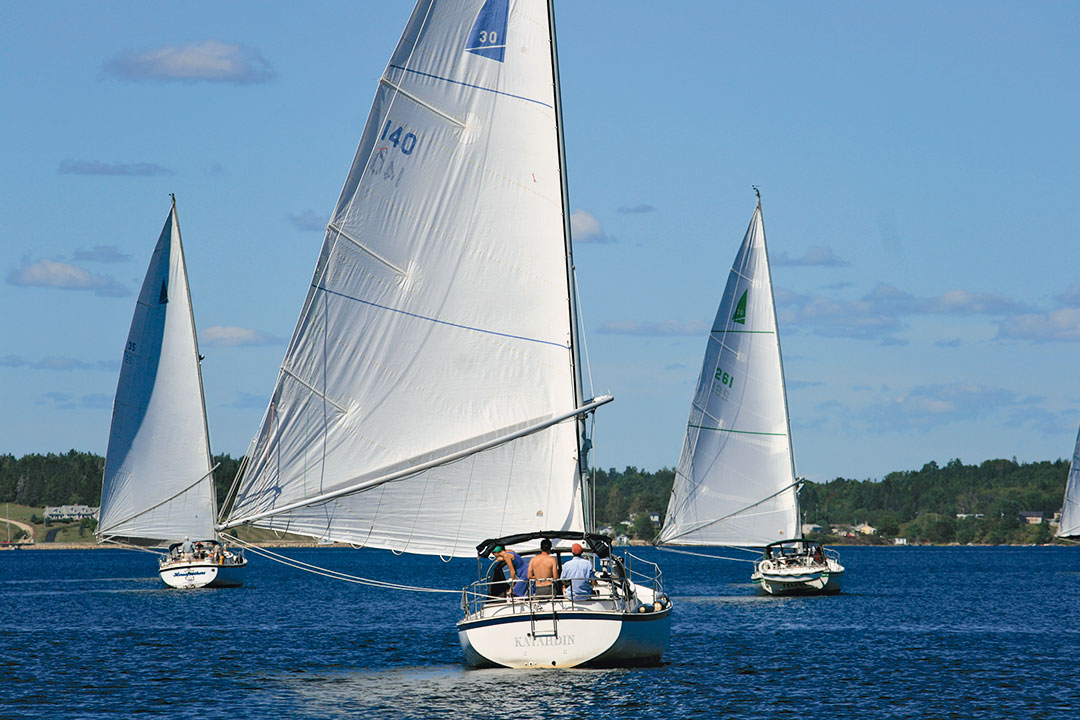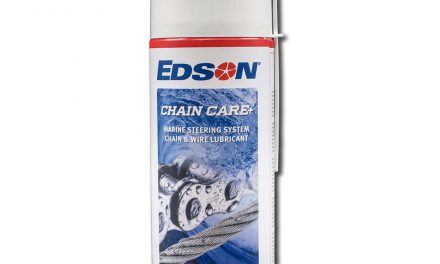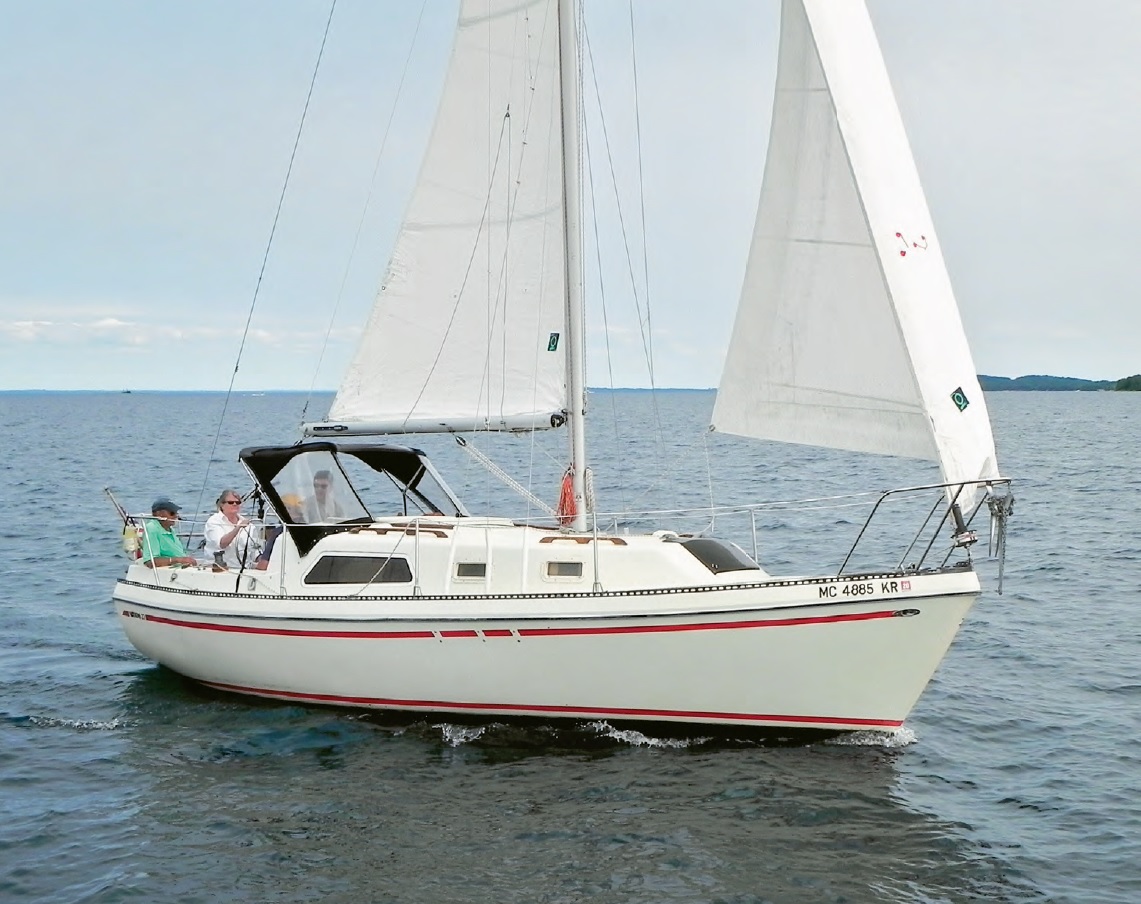A fast, Big Catboat Whose Watchword is Simplicity.
Issue 134: Sept/Oct 2020

To absorb the weight of the mast so far forward, designer Mark Ellis paid special attention to buoyancy in the bow; also note the traditional New England cabin profile with an eyebrow that circles not only the cabintop but also the cockpit coaming—without a break.
Wendy and Frank Glanznig were beating up Lake Huron’s Georgian Bay in a CS30 sloop, tacking hard upwind with rails under, when they saw another boat driving to weather behind them and easily gaining. It was a Nonsuch 30, and as it passed them, they saw “a little old lady by herself in the cockpit,” tucked within a full enclosure. “She was holding a china teacup,” Wendy says, “looking nice and warm, tacking, tacking, tacking, and kicking our behind! Right then, I said, ‘We gotta get one of those!’ ”
And so they did, though they went bigger and purchased hull #1 of the Nonsuch 36, the iteration of this popular, innovative design that many deem the queen of the fleet. Conceived by Mark Ellis as a boat whose essence is simplicity, making it easy for people to get out there and go sailing, the Nonsuch’s signature feature—its unstayed, wishbone rig carrying a single, huge sail—appeals to those willing to experiment and learn, and those with sufficient experience to recognize its advantages.
History
Designed by Ellis, and mostly built by Hinterhoeller Yachts of Ontario, Canada, these boats’ hallmark characteristics are the towering, unstayed mast in the bow, a windsurfer-like wishbone boom, a traditional New England-looking topsides, and a modern and efficient underbody. Nearly 1,000 of the boats between 22 to 36 feet have hit the water since the early 1980s.
Roughly 70 Nonsuch 36s were built from 1983 to 1990. Express Yachts built the first two and called them Nighthawks; when Express Yachts went bankrupt, Hinterhoeller built the rest. The late George Hinterhoeller, a master builder from Austria who emigrated to Canada in 1952, was a founding partner in C&C Yachts in 1969. He left C&C in 1975 and began building under the name Hinterhoeller Yachts in 1977, introducing the first Nonsuch, a 30, in 1978. The 36 followed in 1983.
One reason these boats remain so popular is the strength and support of the owners’ group, the International Nonsuch Association. Although the last boats were built three decades ago and the factory is long gone, about two-thirds of current owners are members of the association. Their discussion forum is exceptionally helpful and above average in civility. The Nonsuch.org website also has digitized copies of owner’s manuals, brochures, factory and owner-contributed maintenance recommendations, and sailing guidance.
Design and Construction
The factory brochure described Nonsuches as, “Greyhounds masquerading as catboats.” To get a sense of what this means, look at a Catalina 36 of the same era. The Nonsuch 36 has 8 inches more beam, 3 feet 6 inches more waterline length, 188 square feet more sail area, a full ton more displacement, and a mast a dozen feet taller. Its theoretical hull speed, 7.78 knots, is .4 knots faster than the Catalina. On the outside, it’s easy to mistake for a 40-footer. On the inside, it’s easy to mistake for a 42-footer.
The Nonsuch concept was a collaboration between Ellis, Hinterhoeller, and the boat’s first customer, Gordon Fisher, who wanted a shorthanded one-design racer for himself and fellow Toronto sailors. Ellis says his design inspirations were the Laser, Finn, and International 14 racing dinghies that he sailed extensively on the St. Lawrence River and the Great Lakes. His approach for each of the Nonsuch models was to treat it as a racing dinghy but add enough buoyancy above the waterline in the bow to keep it from burying its nose. Next, he refined the design to add balance and avoid weather helm through a combination of hull shape, keel structure, and rudder design. The wishbone rig to manage sail shape was inspired by the rigs of windsurfing boards (Ellis was an avid boardsailor) but proven for big boats by Garry Hoyt’s Freedom line as well as 19th-century Herreshoff designs.

Without any shrouds to get in the way, the Nonsuch 36 can sail dead downwind with the mainsail run out past 90 degrees.
People don’t expect the boat to perform well upwind. This surprises Ellis. Lasers and Finns do extremely well upwind, he points out; there’s no reason a larger boat inspired by them wouldn’t.
The boats were heavily built and generally well constructed. Deck and hull are fiberglass over balsa core, with reinforcements as needed in the deck. The keel is an external lead casting.
Chocks are incorporated in the deck bulwarks running all the way around. These are bolted to the hull through a stainless steel cap rail with a vinyl insert. This is one source of deck leaks in some boats, although the boats are generally regarded as tight.
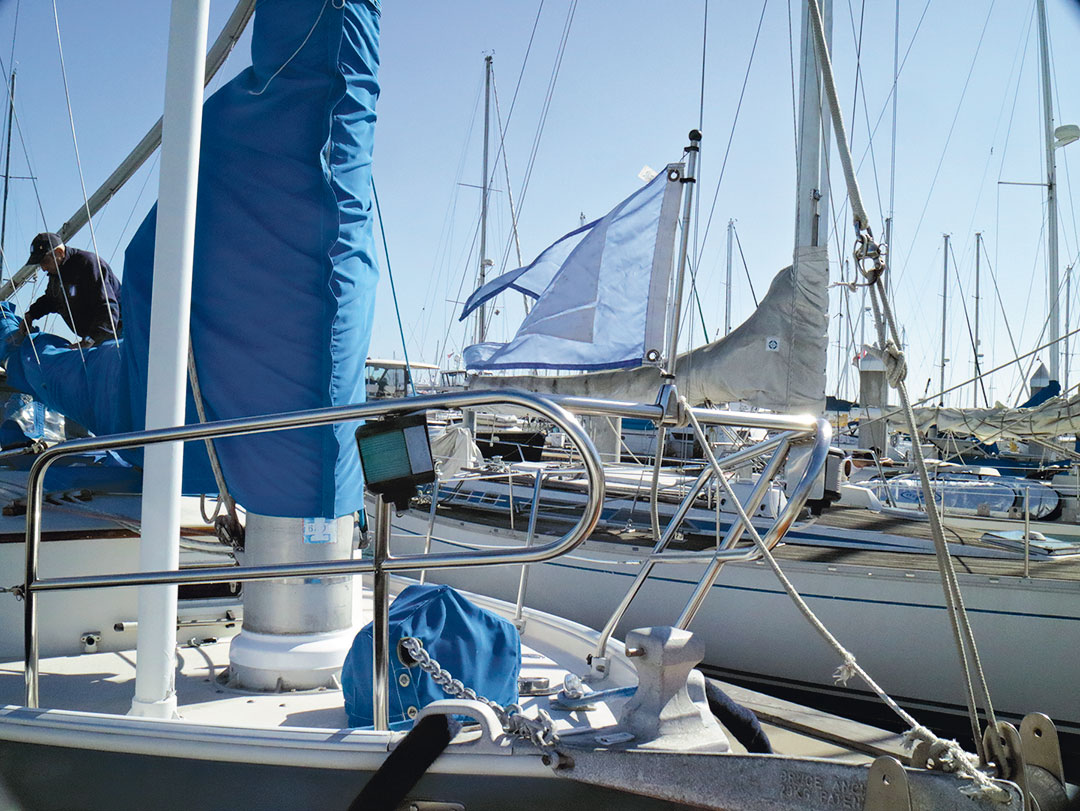
With the large-diameter mast so near the stem, there’s barely room for an anchor windlass. The white post at left is a radar mast.
The most expensive risk factors lie in and around the unstayed, keel-stepped mast in the bow. The mast drops through a large hole in the deck. Surrounded by an aluminum collar, it is wedged in place with a set of chocks and covered with a mast boot. Below, it sits on a heavily reinforced aluminum base that is firmly attached to the keel. This usually works well, but these are key areas to check for water intrusion damage. Several factory notices discuss mast attachment, reinforcement, and crack avoidance. Potential buyers should carefully check the mast and its supporting system. Also, drilling holes in the mast can lead to cracking and should be avoided.
The original engines were 52-horsepower Westerbeke diesels. Owners consider OEM replacement parts spectacularly overpriced. Phil LeVine co-owns Nonsuch 36 hull #3, MeSays, with his wife, Sheri Ross. He recently repowered with what Westerbeke advertises as a drop-in replacement; he reports that this was nowhere near the case.
Original tankage was 49 gallons of diesel fuel, 112 gallons of fresh water, and 45 gallons of waste. The owners’ group has negotiated group rates for 3/8-inch-thick, roto-molded replacement water and waste tanks of the same volume. Many owners have upgraded to these over the years, and/or added additional tanks.
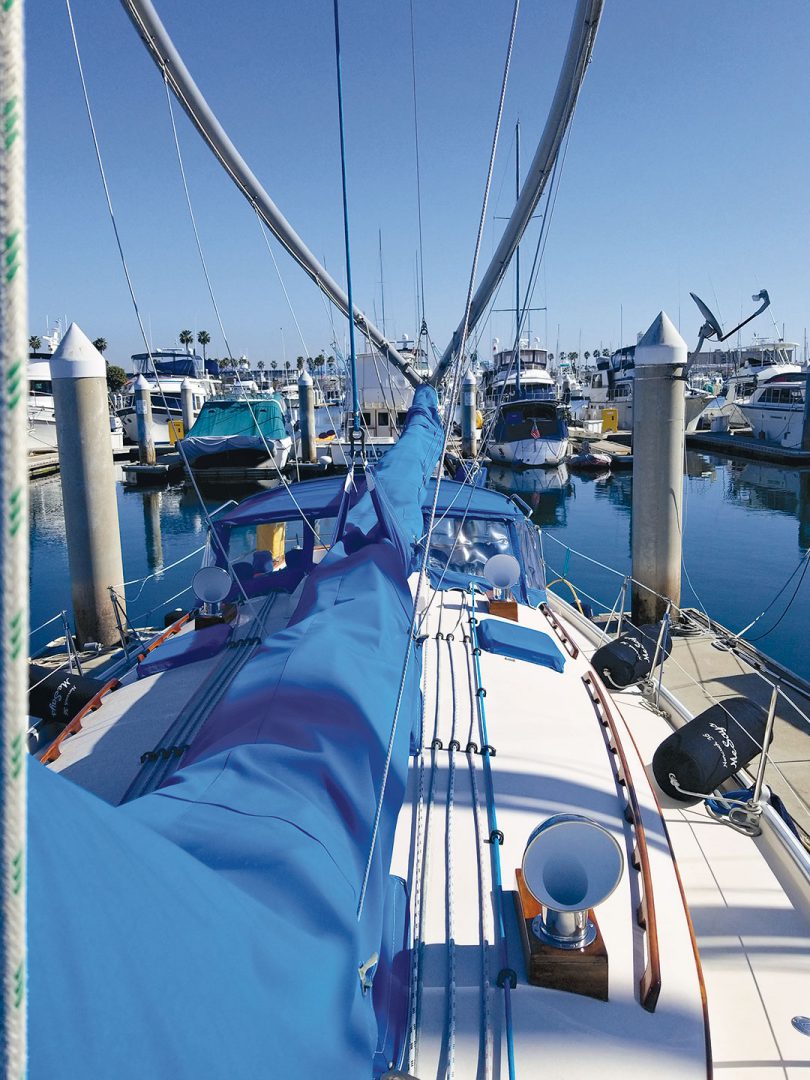
Looking aft from the mast at the wishbone boom and the myriad sail control lines, all led aft to the cockpit.
On Deck
It’s perhaps a good thing that the boat needs little crew. The cockpit is relatively small—comfortable for four, maybe six, but increasingly crowded above that. Deep coamings surround it, making seating comfortable and safe.
The cabintop runs over half the length of the boat. It’s highly crowned and stops just short of the mast in the bow. This doesn’t allow for much seating outside the cockpit. The sidedecks are comfortably wide, though, so moving forward is easy (especially with no shrouds to work around). Heavy cleats are at the bow, amidships, and stern on both sides.
Below Deck
Despite the racing pedigree, Ellis had the vision to design the Nonsuch 36 for long-range coastal cruisers and live-aboards, and the boats remain ideal for that purpose.
The companionway drops almost to the cabin sole, with a four-step ladder down to the huge interior. A large engine room behind the ladder runs underneath the cockpit sole almost to the stern. There’s a spacious lazarette, wet locker, and navigation table to port, and a commodious quarter berth to starboard. A standing-headroom head with separate shower area is next to port, with an aft-facing U-shaped galley to starboard. Next comes an open saloon with U-shaped seating around a table for six to port and a long settee to starboard.

Though not large, the cockpit feels very secure with high coamings.
The stateroom forward has a double berth to port, counter and sink to starboard, and numerous lockers throughout that include access to the bow (where the anchor chain/rode locker and mast reside). In addition to roomy accommodations, the Nonsuch 36 is notable for huge amounts of storage space and well-thought-out access to maintenance items.
You could easily entertain eight people in the saloon, serving gourmet food from the galley. But I’d want to kick half of them off the boat before sailing.
LeVine adds that, “The boat is fabulously ventilated—10 opening portlights by Atkins and Hoyle and four large hatches. Also, four Dorade vents and two solar fans make the boat very dry and well ventilated when a breeze inside is needed.”
Underway
I went for several sails on LeVine’s Nonsuch 36. On a pleasant Southern California February afternoon, midway between San Pedro Harbor and Catalina Island, MeSays made an impressive 5.7 knots upwind in 13 knots apparent at a wind angle under 30 degrees. Returning through the harbor entrance on a close reach in 19 knots apparent, the GPS recorded 7.46 knots. LeVine has hit 9.1 on a beam reach in 17 knots apparent.
Sailing year-round in the ocean channel between mainland Southern California and Catalina Island, LeVine often encounters afternoon winds in the high teens to low 20s. The wind can approach 30 knots before he considers a first reef.
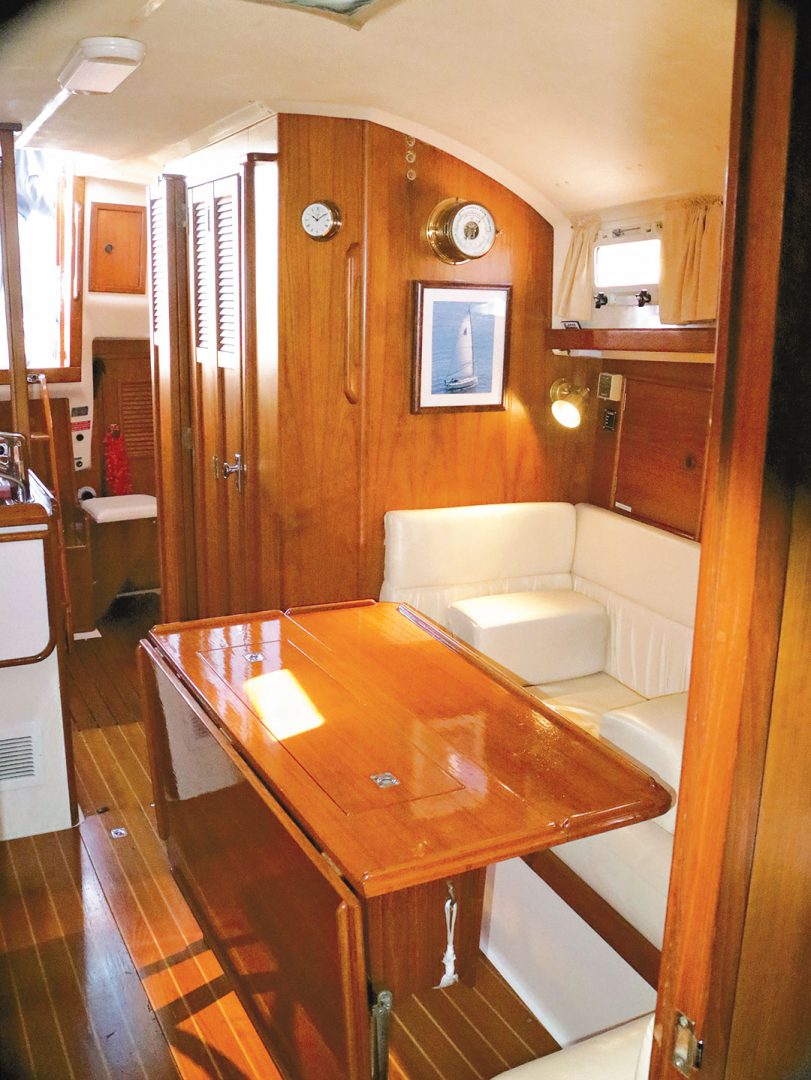
MeSays’ saloon has been well kept with fresh varnish and handsome upholstery.
The single, enormous sail provides a great deal of power, making electric winches for the halyard and mainsheet pretty much mandatory. To take the work out of raising and lowering the sail, owners prefer either more slippery bronze sail slides or retrofitting a low-friction sail track system such as those made by Tides Marine.
One advantage of the unstayed mast is that its highly tapered top section flexes to spill air when the wind picks up. This helps make the large sail more manageable than appearances would suggest. That feature combines with 6,500 pounds of lead ballast to control excessive heeling. Consequently, the boats sail remarkably flat. Ellis recommends using rudder feel rather than heel or weather helm to guide reefing. “Reef when you feel the rudder dragging,” he says.
Nonsuch 36s move well, with a seakindly motion. This point was driven home on another sail, from Redondo Beach to San Pedro. A submarine trench comes to a point just off Redondo Harbor, exacerbating the waves formed as ocean depths recede from several thousand feet to less than 60 feet within a few miles. If you want to test how a boat does in steep seas and confused chop, this is a good place to go.
Steering is light. The boat is responsive and will pick up speed quickly when well trimmed. But, being forgiving, it will not draw attention to itself. If you’re admiring the blue skies and watching the dolphins jump, it’s easy to drift 20 to 30 degrees off course before realizing you’ve slowed down and aren’t heading where you thought you were.
The sail controls and rigging are simple, although unusual. The wishbone boom is held up by a topping lift aft, angling upwards at about 20 degrees forward and held up at the mast by a pair of fixed lines. Five jacklines, each hanging from one side of the boom to the other, form a cradle holding the loose-footed sail when dropped. The natural tendency of the boom is to pull down and forward. The downward force eliminates the need for a boom vang. The forward force is counteracted by a single line called a choker that pulls the wishbone aft, flattening the sail.

The secure U-shaped galley has enabled some owners to cook gourmet dinners underway, at right. Owner Jim Hartling says that during one race, “we encountered prolonged winds in excess of 40 knots, while still accomplishing an oven-roasted chicken and prime rib roast with Yorkshire pudding.”
Gung-ho and racing Nonsuch sailors tweak the topping lift and choker as frequently as other sailors play travelers, adjust vangs, tension halyards, and tweak sheets. However, many Nonsuch owners simply set their sail shape for the general conditions and then just sail for the rest of the day. The only control that requires some attention is the 100-foot mainsheet, which runs through two-part blocks and a turning block to a cockpit winch near the helm.
No jib, no jib sheets. Consequently, no complexities coming about. When it’s time to tack, you just give the wheel a quarter turn. No muss, no fuss.
Jibing, however, must be done with full consideration of all the power captured by a 742-square-foot sail. Some owners sheet in and release the sail back out after carefully crossing the wind. Others simply perform a surprisingly effective 270-degree tack. Still others jibe in a hard-to-explain S-curve maneuver. This last looks great when executed well. It’s a different story if mistakes are made and that 100 feet of mainsheet catches the skipper or an innocent bystander while whipping across the cockpit.
At age 79, LeVine says the main reason he asks others to help sail the boat is just to keep them from feeling left out. It’s that easy to sail. This is why they’re so popular with shorthanded sailors, and why so many owners keep going well after others their age have been forced to retire from sailing.
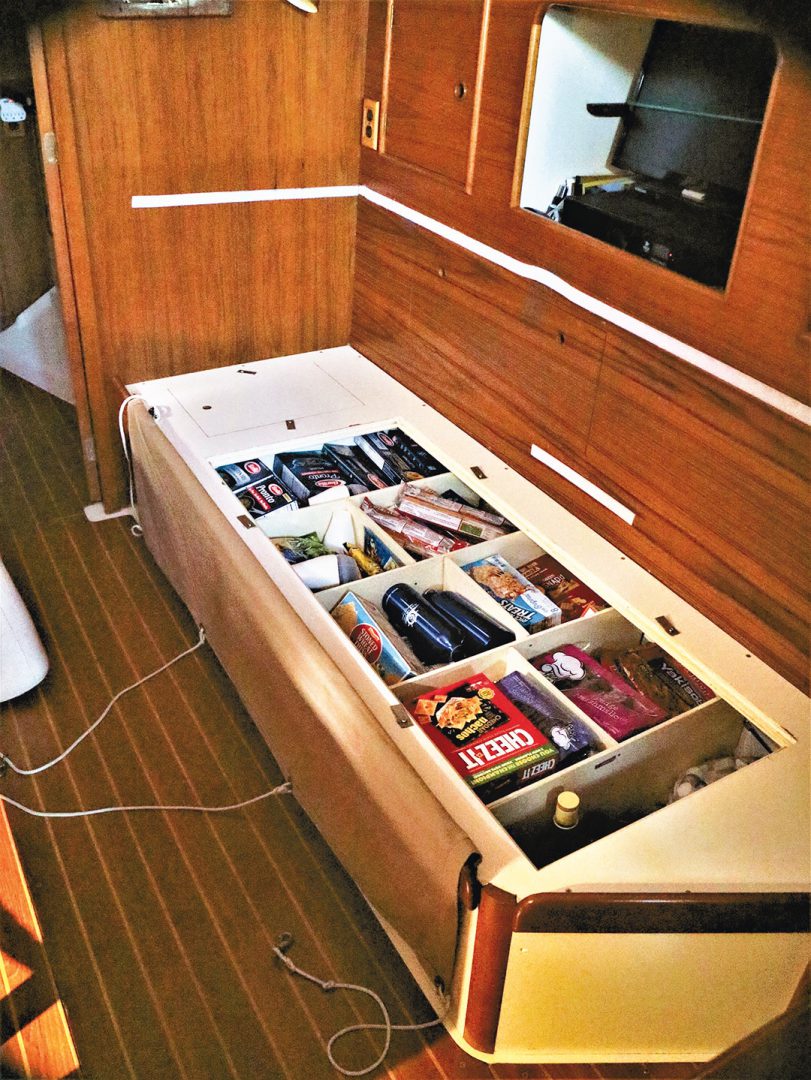
Space under the starboard settee has been compartmentalized for orderly stowage of supplies. Note the lee cloth and lines for making up a sea berth underway.
Conclusion
The Nonsuch 36 is exceptionally easy to handle. Although built to enable long-range coastal cruising, the simple rig and good performance make it easy for owners to take them out as daysailers and go in whatever direction provides the best sailing. Racing them is also popular.
The boats may have a reputation as being for geriatric sailors, but the age of the ownership is probably far more due to unwillingness to let go of a great boat than anything else. Easy to handle, yes. Comfortable, yes. Sedate? Not unless you want it to be.
The Nonsuch 36 is what I would call a “serious” boat. They are substantial in size, and one would do well to remember Ferenc Máté’s enjoinder in Shipshape: The Art of Sailboat Maintenance: “If you think your boat’s too small, try doing the bottom yourself.” Likewise, sliding multiple 20-plus-foot-long full battens back into the pockets of a Nonsuch 36 sail is a similarly infrequent but illuminating experience.
The Nonsuch 36 is not hard to maintain, but when you’re getting a lot of boat for its size, you’re also getting a lot of boat to maintain. Nonsuch owners who want reduced maintenance prefer later boats in which stainless steel replaced teak for handrails. Some have made extensive replacements of wood with faux teak products such as Plasteak.
Many are quite well-equipped, with lots of systems to maintain. LeVine’s, for example, has a watermaker, radar, chartplotter, forward-facing sonar, two radios, HVAC, inverter, power windlass, Harken electric winches, and so on. The rig is very sturdy, but unusual enough that riggers who understand and can maintain it are rare and valuable.
As of this writing, there were three 36s for sale at prices ranging from $68,000 to $70,000. Prices usually vary more, depending on condition, equipment, and location. They offer a lot of boat for the money.
As a retired engineer, I see creative ideas as good. Things that work are better. Creatively combining things that work is best. That’s what makes the Nonsuch 36 a best old boat.
Robert Neches is a retired R&D manager. Sailing year-round in Southern California, he has owned and maintained one boat or another continuously since 1984. His personal motto is, “Sailing boats, plus working on them—two hobbies for the price of three.”
Thank you to Sailrite Enterprises, Inc., for providing free access to back issues of Good Old Boat through intellectual property rights. Sailrite.com


